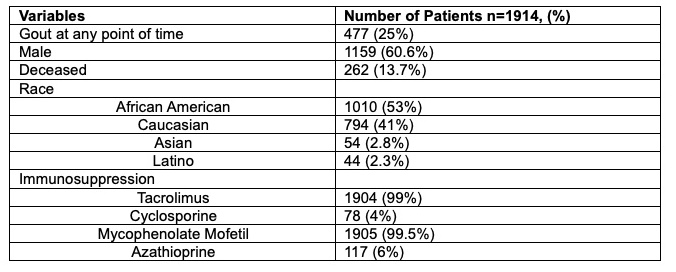Session Information
Date: Sunday, November 12, 2023
Title: (0229–0251) Metabolic & Crystal Arthropathies – Basic & Clinical Science Poster I
Session Type: Poster Session A
Session Time: 9:00AM-11:00AM
Background/Purpose: Gout has been associated with high rates of morbidity and mortality in kidney transplant (KT) patients with increased bone destruction and associated cardiovascular and kidney disease progression after transplantation. The incidence of gout after transplant has been reported to be 7-13%. [1, 2] Cyclosporine, which has been the mainstay immunosuppressive therapy after KT, has been associated with hyperuricemia and gout; however its use in KT has markedly decreased. [3] There is a paucity of studies comparing the incidence of gout and hyperuricemia in KT patients since the adoption of newer immunosuppressive therapies and overall less to no use of cyclosporine. We hypothesize that KT recipients have lower frequencies in incidence of gout with regimens excluding the use of cyclosporine.
Methods: Our population consisted of all patients ages 18 and above who received a KT at our institution between 01/01/2013 and 01/01/2023. We excluded patients with history of gout prior to transplant. Using ICD-10 codes and our institution’s medical records informatics software, we identified patients that were diagnosed with gout after receiving KT. Patient demographics and immunosuppressive therapies prior to diagnosis of gout were analyzed. Categorical variables were reported as frequency percentages.
Results: A total of 1914 patients underwent KT since 2013. A majority (60.6%) of the source population for the study were male (Table 1). Out of 1914 patients, 477 patients (25%) were identified to have a concurrent diagnosis of gout at any point of time (before or after KT). Most of the patients developing gout at any point were male (72%), and 228 identified as African American (47.8%). Only 71 out of the remaining 1437 gout-free patients (4.9%) had a new diagnosis of gout after KT. Prior to developing gout, 50 of these 71 patients were on tacrolimus, 2 on cyclosporine, 7 on mycophenolate mofetil, and 2 on azathioprine. Hyperuricemia above 7 mg/dl was appreciated in only 35 out of 71 of these patients (Table 2).
Conclusion: In a large population of patients receiving KT, our study reports an incidence of gout comparable to that of the general population and lower than historical reports in KT patients. Most cases of gout after transplant were seen in patients on tacrolimus, however this is likely a reflection of the overall decrease in use of cyclosporine in general. Further studies are warranted to investigate and characterize the burden of disease associated with gout cases associated with KT over the last decade.
- Abbott KC, Kimmel PL, Dharnidharka V, Oglesby RJ, Agodoa LY, Caillard S. New-onset gout after kidney transplantation: incidence, risk factors and implications. Transplantation. 2005;80(10):1383-1391. doi:10.1097/01.tp.0000188722.84775.af
- Baroletti S, Bencivenga GA, Gabardi S. Treating Gout in Kidney Transplant Recipients. Progress in Transplantation. 2004;14(2):143-147. doi:10.1177/152692480401400208
- Tedesco D, Haragsim L. Cyclosporine: a review. J Transplant. 2012;2012:230386. doi:10.1155/2012/230386
To cite this abstract in AMA style:
Panchani N, Gaffo A, Kumar V. Decreased Incidence of Gout After Kidney Transplant over the Last Decade: An Analysis from a Large Academic Renal Transplant Center [abstract]. Arthritis Rheumatol. 2023; 75 (suppl 9). https://acrabstracts.org/abstract/decreased-incidence-of-gout-after-kidney-transplant-over-the-last-decade-an-analysis-from-a-large-academic-renal-transplant-center/. Accessed .« Back to ACR Convergence 2023
ACR Meeting Abstracts - https://acrabstracts.org/abstract/decreased-incidence-of-gout-after-kidney-transplant-over-the-last-decade-an-analysis-from-a-large-academic-renal-transplant-center/


